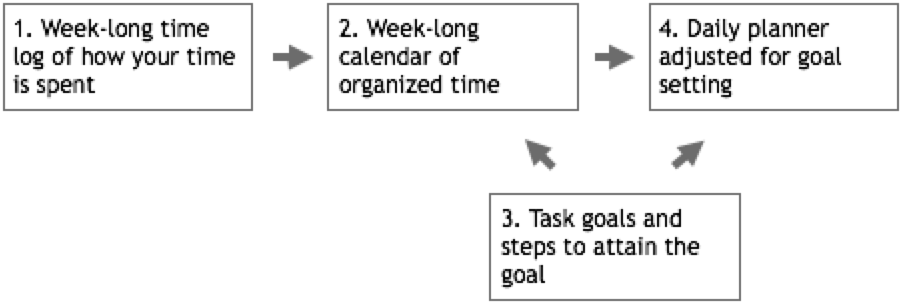Goal Setting
Goal Setting
Goal Setting
A brief literature review completed in the spring of 2016, P Callahan.
A short tale to perhaps make the notion of goal setting a more memorable experience.
I prefer blue ink. That’s a color that makes me want to write. There is something very powerful about writing a goal. Writing is a process that forces both clarification and commitment. The permanence of ink requires me to take the time to organize my thoughts into a statement that is concise and understandable. The goal becomes worthy of my time and effort. I have a plan, a map of my journey.
My preference is to keep a goal statement brief and to-the-point. Reduce a complex task into a simple phrase. I don’t need to worry the details, not yet, anyway. Put limitations to the goal. Limitations make the goal manageable allowing me to determine the what and when of completion. “Hike the Long Trail over the next month.” Is that doable I ask myself. There is nothing to be gained in setting myself up for failure.
A journey is rarely completed in a single step. A step sends us in a direction. The step only has meaning when it has the limitations of direction and distance. Limitation can be a freedom that provides definition, a detail that measures fulfillment or completion.
Goals and Goal setting have a history of research spanning decades and disciplines that include leadership, education and psychology. The notion of goal setting emerged as a recognition of the role of conscious intent as a motivational cause.1,2,3
Given its early history in industrial-organizational (I/O) psychology, goal setting might be broadly defined as the conscious development of a plan to guide a person or group toward a goal or desired end-point, often within some time span. Goal-setting theory considers the impact of motivation, that is, the desire and intent to reach a goal. It implies discontent with the present condition. And, as long as the goal is attainable, there are no conflicting goals, and there is a commitment to the goal, then there is a relationship between goal difficulty and goal performance. This relationship, between goal difficulty and goal performance, contends that harder goals are more motivating than easier goals because they require one to attain more in order to be satisfied.4,5
There are also mediators or mechanisms through which goal setting affects performance. Specifically, goals are motivators, impact persistence, focus attention, and activate old and new knowledge and strategies.6 Other elements or moderators also impact goal setting. Receiving adequate feedback to track progress. Establishing goal commitment that is enhanced by self-efficacy (belief in one's ability to complete tasks and reach a goal) and goal importance. Recognizing that task complexity is limited by task knowledge, that is, task knowledge is more difficult to acquire as the tasks become more complex. And, understanding situational constraints that limit, such as dealing with excess work without having sufficient resources.7
When goals are established by the individual, those individuals who demonstrate higher self-efficacy set more demanding goals than those individuals with lower self-efficacy. Further, the more self-efficacious individuals demonstrate a greater goal commitment and find better strategies to attain the goals.8 This is seen in the context of learning goals. Learners are affected by perceived goal progress leading to goal attainment. Goal setting and self-efficacy are affected by self-observation, self-judgment, and self-reaction.9 The effects of self-efficacy, grade goal, and effort regulation emerge as strong predictors of course grades and Grade Point Average (GPA).10,11 Learners who set both near and longterm grade goals show higher GPA.12
Grit has appeared as a predictor of academic success. It is defined as perseverance and passion for long-term goals, or the effort and interest exercised toward a set goal and positively sustained throughout the course of reaching that goal. Grit is considered a trait that can be nurtured to improve self-regulation and goal success.13,14,15
Finally, as a psychological construct, the framing of goal setting becomes pivotal. For example, individuals who perceive the goal to be a challenge show better performance than those individuals who perceive the goal to be threatening and potentially leading to failure.16 Additionally, setting specific difficult goals leads to better performance than no goals or vague goals, such as "do your best.”17 This is evidenced in behavioral and physical health programs, such as goal coaching as an approach to physical rehabilitation, dietary and exercise programs, personal development, and goal attainment.18,19,20,21
Process of Goal Setting
Goals can range from small to big depending upon individual perception and the resources needed to meet the goal. Getting out of bed in the morning can be a goal, as can writing and presenting a complex report. Making the effort to smile at people can be a goal, as can showing people that we care about them. We may set dozens of goals every day, but may not be fully aware of the implications of the act nor the process we go through to attain the goal. Being able to create an attainable goal and the steps to achieve that goal has been found to increase our sense of self-efficacy, thus producing a positive loop leading to an even greater likelihood of success.22,23,24,25
The goal implications can have unexpected consequences. For example, unrealistic goals can lead to depression and can lead to a self-fulfilling prophecy of failure.26 If goals are too easily attainable, then we can become bored and uninspired reaching the goal. Attainment can be influenced by whether the goals are imposed on us or if we have some say in the development of the goal.27,28
It is important to differentiate between the notion of goal commitment from that of goal acceptance.29 We may accept that studying for classes is a goal that we have to make to reach the larger goal of graduating from our program of studies. If, however, we are not committed to studying on a daily basis we may fail to graduate. There are intrinsic and extrinsic motivations to achieving a goal.30,31 That is, we may have internal (intrinsic) motivation to achieve a certain goal, when there is no external (extrinsic) motivation to do so. Alternatively there may be little intrinsic motivation, but lots of external motivation to accomplish a goal. Most often our goal setting is derived from some combination of all these factors. Awareness of these factors better permits us to develop a viable goal and the steps needed to attain the goal.
Time Management
Effective time management is problematic for most people and it becomes more complicated when one is balancing family, exercise, social obligations, education studies and a job. Students who perceive control of their time report greater performance and life satisfaction, and less role overload and stress.32 Time management is shown to have a greater buffering effect on academic stress than leisure activities.33 Engaging in some time management behaviors may have beneficial effects on stress and job satisfaction.34,35
A goal of time management is to blend lifestyle with goal setting. A commonly used process is, through a series of steps, to identify how you are currently allocating your time and then perform an optimizing process to better address your activity and time needs. The optimizing process results in a “calendar” or planner that allows you to identify daily routines as well as when special events impact your daily routines. By identifying and compartmentalizing your routines and identifying important activity dates, you can establish boundaries that ultimately permit you to enjoy guilt-free personal time without the stressful thought of “I should be doing …”
Using a notebook, spreadsheet, word processor, or other recording device, create a daily calendar noting by unit of time (hourly, 30 minutes, or 15 minutes) the activity you are performing. Maintain this calendar for one week.
| Time | Monday | Tuesday | Weds | ... |
| 5:00 | wake | wake | wake | ... |
| 15 | feed pet | feed pet | feed pet | ... |
| 30 | jog | feed pet | jog | ... |
| 6:00 | shower | ... | ||
| 15 | shower | breakfast | shower | ... |
| 30 | breakfast | read newspaper | breakfast | ... |
At the end of one week, analyze the use of your time by identifying common activities or tasks and the time spent on these. Activities to consider should include “free time” for family or social activities, classes, work, study, meals and preparation, exercise, and chores. The intent of this weeklong analysis is to create an organized weeklong calendar or a planner that indicates time spent on key activities. For example, identify an adequate amount of “free time” while assuring that you put your most mentally demanding tasks into time slots that make the best use your mental and physical resources. Your planner should be a tool that accommodates your lifestyle.
The week-long calendar of organized time situates the recurring activities appearing in your week-long time l og such that your days are presented in an optimized manner allowing repetitive activities to be identified. Activities to consider should include “free time” for you, family, and social activities. Also consider work, meals and preparation, exercise, studies, and chores.
Task goals and the steps to attain the goal are elements that may or may not immediately appear within the organized weekly calendar, but are added as they arise. Consider setting goals and objectives for work projects. These can be blended into the organized weekly calendar to become a daily planner.

The next step is to translate this information into some sort of daily planner. Your planner should be a tool that accommodates your lifestyle. In its simplest form consider using a shirt pocket planner notebook, a wall calendar, a commercially printed daily planner with calendar, or a software application (app) that runs on your cell phone and is shared with others. Pick the tool that you will use. Time management provides opportunity to enact goal setting.
A Method for Goal Setting
A frequent term used in psychology is successive approximation or an ongoing shaping of behavior towards a desired end.36 The same can be said for the goal setting. A goal is often defined as the conscious development of a plan to guide a person or group toward the goal or desired end-point. It is important to develop a realistic goal along with the smaller, more manageable, informative steps required to attain the goal. These steps or objectives have purpose. Steps can help eliminate goal ambiguity by providing limitations to the broader goal statement. They can introduce more flexibility in attaining the goal.37,38 Steps provide a mechanism for ongoing self-evaluation. They provide opportunities for “rewards” along the way to attaining the larger goal. Too often people focus only on the goal and miss the intrinsic and extrinsic values associated with satisfying the smaller steps towards meeting their goal.
Are there other options for goal setting? While the method described does provide the how-to basics of goal setting, finding other tools, such as dedicated goal setting apps might be beneficial. Consider too, other tools such as acronyms that might prompt you. The SMART acronym captures some of the elements of successful goal setting from a management context. That is, goals are Specific (defined intent), Measurable (limits are established), Assignable (who is involved), Realistic (attainable), and Time Related (expected completion).39 The goal, of course, is to complete the goal setting and if you should find a more appropriate tool that moves you to completion, then use it.

Purchase the Ebook:
A Community of One: Building Social Resilience
The lone wolf is a Hollywood myth. A healthy support system is one in which we both give and receive support. This book is about learning how to develop these crucial networks.

Purchase the Ebook:
Scholars in Camo
This Veterans Curriculum is purposefully designed to increase the likelihood of retention and graduation of learners in college settings by establishing an academic and social framework, which is intended to improve concentration, memory, problem solving, and learning, while minimizing social isolation.
